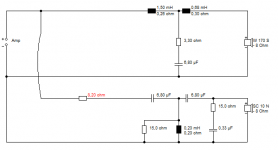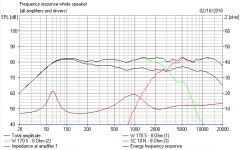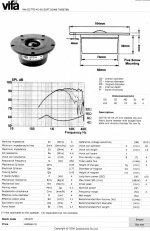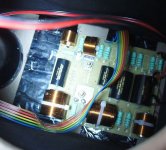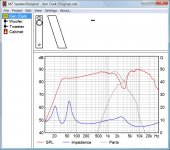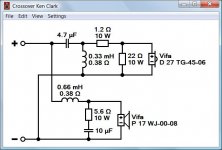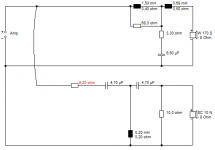I had a little mull over this problem. I read this goodish post:
https://www.diyaudio.com/forums/multi-way/244412-heybrook-hb2r-5.html#post4017352
I thought that Heybrook filter was good, so just simplified it to reasonable buildability. I have no idea about tweeter level really, and would select on test. The red resistor. Nothing very controversial there. All quite familiar 3kHz stuff.
I think this might sound better than most of the dubious 6" speaker designs I see. It's doing all the right BW3 things.
https://www.diyaudio.com/forums/multi-way/244412-heybrook-hb2r-5.html#post4017352
I thought that Heybrook filter was good, so just simplified it to reasonable buildability. I have no idea about tweeter level really, and would select on test. The red resistor. Nothing very controversial there. All quite familiar 3kHz stuff.
I think this might sound better than most of the dubious 6" speaker designs I see. It's doing all the right BW3 things.
Attachments
No doubt you used excellent speakers, the proper Factory designed crossover, and built a very goood, rigid and specially rigid  enclosure.
enclosure.
Results should be flawless, no questions asked.
Yet you report what amounts an excess of highs .... I look at your cabinet and see that the Tweeter is mounted higher than most, angled so as to point exactly at your ears, on axis.
And remember other cabinets measure as flat as yours .... on axis and inside an anechoic chamber for measurement purposes only, and then are usually listened at **OFF** axis.
And I mean the vertical axis which usually nobody cares much about ....
while yours is listened at not only on axis on the horizontal plane (most do that) but also on the vertical plane (not that many).
My point is that you are getting too much of a GOOD thing (a couple Members hinted at something similar) and it´s an unusual experience (for many, not only you), so I suggest to start with the trivial solution:
Tweeter too loud and harsh? ... why not just add an attenuator and adjust to taste?
A rheostat if you can get one, or at least a rotary switch with a couple different attenuation steps.
I´d try the simpler solution before embarking in more complex ones.
Results should be flawless, no questions asked.
Yet you report what amounts an excess of highs .... I look at your cabinet and see that the Tweeter is mounted higher than most, angled so as to point exactly at your ears, on axis.
And remember other cabinets measure as flat as yours .... on axis and inside an anechoic chamber for measurement purposes only, and then are usually listened at **OFF** axis.
And I mean the vertical axis which usually nobody cares much about ....
while yours is listened at not only on axis on the horizontal plane (most do that) but also on the vertical plane (not that many).
My point is that you are getting too much of a GOOD thing (a couple Members hinted at something similar) and it´s an unusual experience (for many, not only you), so I suggest to start with the trivial solution:
Tweeter too loud and harsh? ... why not just add an attenuator and adjust to taste?
A rheostat if you can get one, or at least a rotary switch with a couple different attenuation steps.
I´d try the simpler solution before embarking in more complex ones.
Ahh, cheers mate!Tweeter data sheet for Northern Hemisphere members attached.
JMFahey,
I take your point about the upward sloping tweeter but I usually listen sitting down. However the harshness is certainly more pronounced when standing directly in front of the cabinet.
I have a pair of accurate studio monitors (bass reflex type and purchased, not built by me) and these look to have very similar Vifa drivers to my cabinet.
I opened up the back and had a look at the crossover & although the components were not all marked, the L-pad feeding the tweeter had a 2.2 ohm series resistor & a 10 ohm parallal resistor which, according to my calcs, would give about twice the attenuation as my cabinet.
ken
I take your point about the upward sloping tweeter but I usually listen sitting down. However the harshness is certainly more pronounced when standing directly in front of the cabinet.
I have a pair of accurate studio monitors (bass reflex type and purchased, not built by me) and these look to have very similar Vifa drivers to my cabinet.
I opened up the back and had a look at the crossover & although the components were not all marked, the L-pad feeding the tweeter had a 2.2 ohm series resistor & a 10 ohm parallal resistor which, according to my calcs, would give about twice the attenuation as my cabinet.
ken
I think this speaker has more problems than just a too loud tweeter. I did a vagueish sort of sim. 
I was going to include some images from earlier, but they are too huge.
I just had a look at a successful play on similar 6" plus 3/4" SEAS drivers.
Graham Audio Chartwell LS6 |
If you have a successful similar design, we could certainly look at it in detail. I suppose I could do the whole FRD and ZMA thing, but it's a lot of work and I really have better things to do. For now I fancy some simplish modifications, already outlined. It can't be that hard really.
Curiously, I think the tilted baffle is not a biggie if you get the power response and lobing right. And no reason to reject a complex crossover, though I could simplify further the already suggested one with a 2nd order tweeter if you must. Graham Audio use something that has the look of splendid Harbeth-like high order, below.
But, I'll say again, 6" bass is a difficult speaker to do.
I was going to include some images from earlier, but they are too huge.
I just had a look at a successful play on similar 6" plus 3/4" SEAS drivers.
Graham Audio Chartwell LS6 |
If you have a successful similar design, we could certainly look at it in detail. I suppose I could do the whole FRD and ZMA thing, but it's a lot of work and I really have better things to do. For now I fancy some simplish modifications, already outlined. It can't be that hard really.
Curiously, I think the tilted baffle is not a biggie if you get the power response and lobing right. And no reason to reject a complex crossover, though I could simplify further the already suggested one with a 2nd order tweeter if you must. Graham Audio use something that has the look of splendid Harbeth-like high order, below.
But, I'll say again, 6" bass is a difficult speaker to do.
Attachments
Here we go again. Vague pronouncements about a problem and 30 posts to fix "it".
How about some measurements first instead of wasting everybody's time
Are we at 30 yet?*
B.
*might as well just take JMFahey's idea and just add an L-pad to the tweeter and call it a day
Last edited:
Thanks for the sign off. You've done a bonzer job putting up with the yabber! Do report back to let us know if the simple 'fix' cures your problem.Thanks to everyone who has contributed.
Hi Ken,
I think your speaker deserves an improvement and it doesn't matter if it takes 100 posts to achieve that goal.
Attached is a simulation of your current setup. The deep suckout at the crossover frequency is caused by the recessed tweeter on the tilted baffle. Obviously tweeter polarity has to be reversed first of all.
On the long run you will need a redesign of the crossover (more baffle step correction). But let's do that in the next 70 posts.
I think your speaker deserves an improvement and it doesn't matter if it takes 100 posts to achieve that goal.
Attached is a simulation of your current setup. The deep suckout at the crossover frequency is caused by the recessed tweeter on the tilted baffle. Obviously tweeter polarity has to be reversed first of all.
On the long run you will need a redesign of the crossover (more baffle step correction). But let's do that in the next 70 posts.
Attachments
+1TDo report back to let us know if the simple 'fix' cures your problem.
Ken Clark - do try using your laptop mic and honourware REW. REW has a learning curve but you'll soon be buying a mic and be very pleased with your new powers of measurement.
Easy to buy a mic and a second-hand mic mixer to supply "phantom" power to mic and flexibility. Easier to work with than a USB mic.
Good luck.
B.
On the long run you will need a redesign of the crossover (more baffle step correction). But let's do that in the next 70 posts.
This needs to be the first thing to fix. It will affect the crossover point tremendously, and possibly go a long way to correcting the phase. Certainly the tweeter level will have to come down lots more.
I'd rather do this stuff in the forum than via PM. Ken asked me about third order circuits to try, rather than the failed second order one which he has adjusted for tweeter level.
Vifa P17Wj 6" well-behaved polycone. Vifa 92dB tweeter. Sort of thing Marhall Leach did years back: Vifa 2-Way Loudspeaker System
I've seen nothing to change my view that third order around 3kHz is the way to go here:
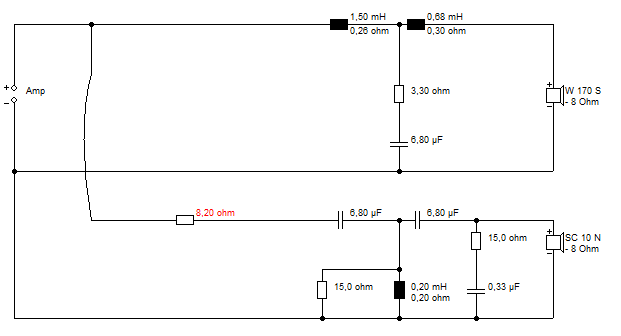
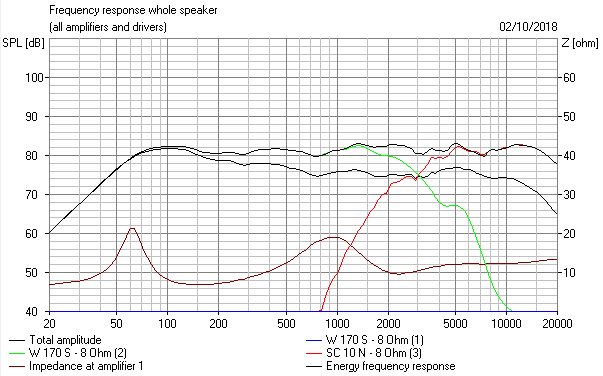
This is essentially a Heybrook HB2 circuit, designed by Peter Comeau. I like it.
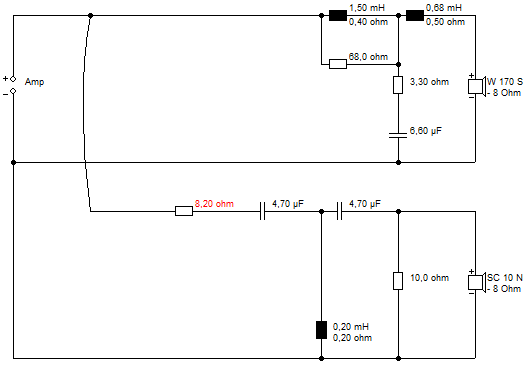
Bit simpler, but not far different. You might get away with losing the 68R and 0.68mH coil. IDK.
Thing is, all these simple circuits are good fun, but the Pros use higher order: Graham Audio Chartwell LS6 |
Draw your own conclusion.
Vifa P17Wj 6" well-behaved polycone. Vifa 92dB tweeter. Sort of thing Marhall Leach did years back: Vifa 2-Way Loudspeaker System
I've seen nothing to change my view that third order around 3kHz is the way to go here:
This is essentially a Heybrook HB2 circuit, designed by Peter Comeau. I like it.
Bit simpler, but not far different. You might get away with losing the 68R and 0.68mH coil. IDK.
Thing is, all these simple circuits are good fun, but the Pros use higher order: Graham Audio Chartwell LS6 |
Draw your own conclusion.
Personally I don't believe the dcr of the inductor is that critical.
Yes ok lower dcr on bass inductors are better.
But don't stress if it's not exactly right.
For lower dcr you need to look at larger gauge wire for air cores, or some sort of cored inductor.
A quick search brought up these from speakerbug. (I've used their products before)
1.5mh 18awg 0.64ohms
1.5mh 15awg 0.37ohms
1.5mh 17awg 0.18ohms Cored inductor
This one is lower dcr than the 15awg air core, but it's also much cheaper.
Yes ok lower dcr on bass inductors are better.
But don't stress if it's not exactly right.
For lower dcr you need to look at larger gauge wire for air cores, or some sort of cored inductor.
A quick search brought up these from speakerbug. (I've used their products before)
1.5mh 18awg 0.64ohms
1.5mh 15awg 0.37ohms
1.5mh 17awg 0.18ohms Cored inductor
This one is lower dcr than the 15awg air core, but it's also much cheaper.
- Status
- This old topic is closed. If you want to reopen this topic, contact a moderator using the "Report Post" button.
- Home
- Loudspeakers
- Multi-Way
- Two Way Crossover
